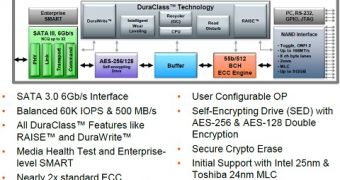SandForce has announced today its first product after being acquired by LSI, a new solid state drive processor known as the SF-2481, which was specially designed in order to be used in SSDs developed for cloud computing environments.
The controller is based on SandForce’s already available SATA 6 Gbps solutions, but it was specially tweaked in order to better meet the needs of cloud services providers.
Just like its consumer counterparts, the SF-2481 works with Multi-Level Cell (MLC) memory to provide high density storage at lower prices.
However, this now features a more advanced error correction algorithm and Predictive Failure Analysis capabilities, which the company promises will improve its reliability.
Furthermore, the provision space reserved by the drive can be configured by the system’s admin to balance endurance with performance, according to the needs of that particular cloud environment.
As far as performance goes, sequential read and write speeds will top at about 500MBps, while random read and write speeds are estimated by SandForce at about 60,000IOPS (input/output operations per second).
At the same time, the SSDs built using these controllers can also encrypt the information stored for higher date security using a double AES encryption equal to 300-bit protection with Secure Crypto-Erase control.
"Storage needs in Cloud computing is exploding worldwide, and to optimize the total cost of ownership, the cloud environment needs solid-state storage that performs at the highest levels with the greatest longevity and reliability on standard MLC flash,” said Jeremy Werner, Director of Marketing for SandForce.
“The SF-2481 SSD Processor was specifically designed to deliver the perfect combination of performance, endurance, and intelligence required in cloud computing data centers,” concluded the company’s rep.
The just announced SF-2481 SSD processor is sampling to OEMs now and will ship in mass production in January of 2012.

 14 DAY TRIAL //
14 DAY TRIAL //